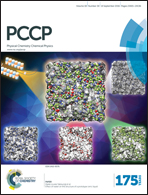Benchmark calculations of excess electrons in water cluster cavities: balancing the addition of atom-centered diffuse functions versus floating diffuse functions†
Abstract
Diffuse functions have been proved to be especially crucial for the accurate characterization of excess electrons which are usually bound weakly in intermolecular zones far away from the nuclei. To examine the effects of diffuse functions on the nature of the cavity-shaped excess electrons in water cluster surroundings, both the HOMO and LUMO distributions, vertical detachment energies (VDEs) and visible absorption spectra of two selected (H2O)24− isomers are investigated in the present work. Two main types of diffuse functions are considered in calculations including the Pople-style atom-centered diffuse functions and the ghost-atom-based floating diffuse functions. It is found that augmentation of atom-centered diffuse functions contributes to a better description of the HOMO (corresponding to the VDE convergence), in agreement with previous studies, but also leads to unreasonable diffuse characters of the LUMO with significant red-shifts in the visible spectra, which is against the conventional point of view that the more the diffuse functions, the better the results. The issue of designing extra floating functions for excess electrons has also been systematically discussed, which indicates that the floating diffuse functions are necessary not only for reducing the computational cost but also for improving both the HOMO and LUMO accuracy. Thus, the basis sets with a combination of partial atom-centered diffuse functions and floating diffuse functions are recommended for a reliable description of the weakly bound electrons. This work presents an efficient way for characterizing the electronic properties of weakly bound electrons accurately by balancing the addition of atom-centered diffuse functions and floating diffuse functions and also by balancing the computational cost and accuracy of the calculated results, and thus is very useful in the relevant calculations of various solvated electron systems and weakly bound anionic systems.


 Please wait while we load your content...
Please wait while we load your content...